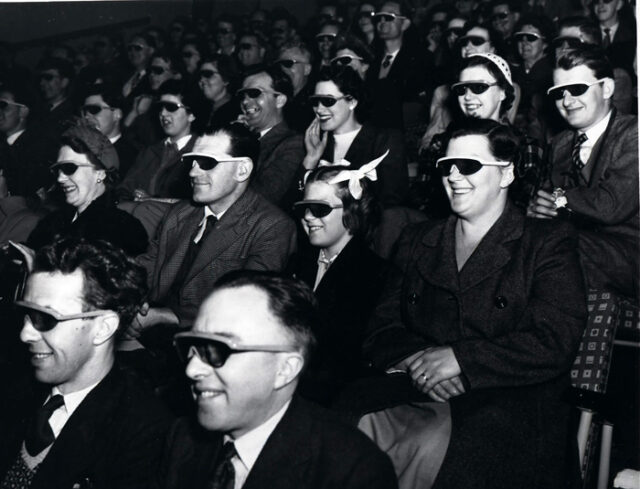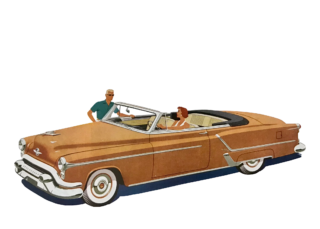
One of my most important moviegoing experiences happened shortly after I graduated college, when I was old enough to know better and vain enough to think I couldn’t be fooled. I was supposed to be writing about an experimental film that was scheduled to play at the Museum of the Moving Image in Queens, New York. About a week before the film opened, I went to a private screening. Private usually meant that only press and industry people were allowed in, but that morning it meant I had the theater to myself. Which, since the theater was the Sumner M. Redstone, one of the most fetchingly designed in the city, was not such a bad thing. I put my feet up and allowed my gaze to drift from the hallway (thick blue light) to the walls (geodesic, with a strong whiff of 2001: A Space Odyssey) to the chunkily patterned curtain (rainbow spikes, aimed at my eyeballs). After a few minutes, the lights dimmed, and the curtain split down the middle.
Titles of experimental films tend to be either extremely literal or extremely obscure. The title of film I was supposed to write about was Readers, and it was about people sitting in front of the camera reading books in silence — i.e., readers. Except for transitions from one person to another and some brief shots of what they were reading, there were no cuts, just a sedentary camera staring at sedentary readers staring at their books. The whole thing lasted about two hours.
At the time, I thought that Readers was very, very interesting. Nothing much happened, but nothing much happens in Ulysses or Seinfeld or a Cezanne still life, either. By keeping plot (and action, and dialogue, and music, and movement) to a minimum, I told myself, the film had graced me with the opportunity to bask in the beauty of banality — the folds of a T-shirt, say, or the rustle of a finger on a page — and read it as carefully as the onscreen readers seemed to be reading their books. At first, I zeroed in on faces and bodies, but after a while I started exploring the corners of the screen and taking in the rugs and houseplants and windows. A little while after that, my gaze drifted away from the screen entirely and back to the walls and the curtain and the needle of blue light under the red EXIT sign, which, had I been completely honest with myself that morning, were much more appealing sights than the rugs, houseplants, or windows. At some point I got up to pee. While I was peeing, I must have checked my phone. At some other point I’m sure I scratched my crotch.
When the film was over, I got on the train, went home, and wrote a review that was wanly complimentary and (obviously) godawful. I can’t stand to look at it now, but I remember feeling proud of myself for working in a Flaubert quote about the beauty of the everyday, and I’m positive there was nothing about either the blue light under the EXIT sign or scratching myself. I forgot about Readers pretty much as soon as I sent off my review; why I’ve been thinking about it again lately I can’t completely explain. When I do think about it, in any case, I’m annoyed — approximately 1 percent at the film and 99 percent at myself. I’m annoyed with Readers for conning me into writing wanly positive things about it, and with myself for allowing it to con me. To be clear, I usually enjoy being conned by movies — it’s one of my favorite pastimes — but this particular con wasn’t charming or sexy or well thought-out. Like Anna Delvey, Readers just kind of stood around and expected the world to give it what it wanted, and like the SoHo suckers who threw their dollars at Anna Delvey, I assumed Readers was the kind of thing I should take seriously.
Here’s why I no longer do: none of the readers in Readers scratch their crotches. Nor do they yawn, hum, pick their noses, check their phones, absent-mindedly talk to themselves, tap their fingers, chew their fingernails, make eye contact with the camera a few feet away, count the ceiling tiles, or burp. If they had, the film might have been an interesting work of art. But instead, they just sit there, reading or pretending to read. Readers is as implausible, as artificial, and at least as simpleminded about human nature as Avengers: Endgame, and as with Avengers, there is something basically aspirational about this simplemindedness. You watch a superhero adventure in order to feel like a superhero, blessed with a powerful body and a nobly uncomplicated brain; you watch a film like Readers in order to feel like a philosopher king, more brain than body, incapable of boredom, a diligent student of reality. In short, an ideal arthouse cinema patron.
One possible reason I’ve been thinking about Readers again is that artists and art-lovers seem to be getting more and more absorbed with the ideal of aesthetic absorption. It was always there in some form, but recently I’ve noticed it becoming less of a means to an end and more of an end in itself; whatever else the work of art does, whatever themes or tones the artist employs, it must leave the audience as absorbed as the readers in Readers. This is just my observation, of course. But it makes sense in supply-and-demand terms: when every second of existence hums with a hundred digital distractions, what higher achievement for art than to make us put down our phones? Seen this way, the greatest art must grip, rivet, hypnotize, enthrall; it’s the prison to which you cheerfully sentence yourself.
This is a common enough way of thinking about popular, unpretentious entertainments (“those two hours just flew by!”), but it fits the avant-garde almost as snugly. When the mainstream strives for total absorption, the avant-garde strives for total sore-ass, grab-the-Tylenol difficulty — the monkish hairshirt to mainstream Hollywood’s bacchanalia. The weird part is that the avant-garde mirrors the assumptions of the mainstream without meaning to, just as medieval monks once performed an unconscious parody of peasant hedonism, a gluttony of suffering to rival the gluttony of the feast. If you are a Very Serious Aesthete, aesthetic culture will often compel you to act as though you are utterly absorbed by the avant-garde, a mind without a crotch.
Either you have no sense of what I mean, or you know all too well, but in the New York repertory movie theaters I frequent, you can’t walk three feet without overhearing some example of this phenomenon. Cinephiles love to half-joke about getting their fix or mainlining movies or bingeing Nathaniel Dorsky, as though cinema were a drug to which they’re proudly addicted, instead of a mystery to be pondered for a lifetime, embraced and renounced and embraced all over again. This isn’t merely a case of the avant-garde mirroring the aesthetic categories of the mainstream, either; I’m sure the higher-up culprits — not just in cinephile culture but in culture, full-stop — are good old-fashioned stubbornness and arrogance (they definitely kept me in my seat that morning at the Museum of the Moving Image).
Not too long ago, I watched three distinguished novelists discuss William Gaddis’s The Recognitions. One of the first questions was about that novel’s difficulty, at once a reason for and an obstacle to its popularity. One of the novelists gave a cute answer. How strange, he said, that we’ve learned to enjoy the mystery of walking down the street, catching glimpses of signs or hearing snippets of chat — but when a novel tries to mimic the same experience, we get frustrated because we can’t precisely understand every sentence on every page! Well put, but for the next ninety minutes I waited for somebody to say they didn’t understand this sentence or that page. Nobody did. The novelist’s confession had the fashionable faux-humility of a Fortune 500 corporation making an indigenous land acknowledgment. All three distinguished novelists were willing to admit, in theory, that they didn’t continuously understand and thus weren’t continuously absorbed. But in practice, none wanted to be the first surrender. No less than the readers in Readers, they could feel the camera quietly judging them.
Another likely reason I’ve been thinking about Readers again: for the last few months, after a long involuntary leave of absence, I’ve been going to movie theaters regularly, and I’ve been pleasantly surprised to find that movie theaters are not quite as I remembered them. It was easy in July 2020, when I was trying to Google COVID testing sites and watch Taste of Cherry on the same smudged screen, to misremember theaters as churches for hushed movie-worship, no distractions allowed. That summer I probably read at least a dozen articles that painted some version of this picture. It’s a nice picture. The problem, it seems to me, is that by idealizing movie theaters, you set yourself for inevitable disillusionment — see A. O. Scott in the New York Times, first crafting “a fantasy of film democracy” and then scolding theaters for failing to live up to his own straw man fantasy: “Was the theater full of crying babies? Talkative senior citizens? Unruly teenagers? … Was the floor sticky? Was the seat torn?”
Who needs straw men when the reality is so endearingly, raggedly imperfect? If a movie theater has ever embodied the fantasy of film democracy, it must have been before I was born — today they’re about as democratic as the United States of America. If they’re classrooms, they’re the kind with one hungover teacher and thirty-five students all passing notes or sexting. If they’re churches, they’re the plastic Vegas chapels where couples marry and divorce the minute the drugs wear off. For the most part, theaters are (of course) cynical, soulless, evil places subservient to the profit motive. But how does that make them different from anywhere else? They’re a dirty business, but there’s delectable dirt to be found: the cruise-ship scale of the buildings themselves, for starters; the little “aha” of snickering in unison with the stranger to your left; even, at times, the unruly teenagers of Scott’s nightmares.
Movie theaters aren’t refuges from distraction, then; they just have better distractions than any you’re likely to find in the home. The major advantage of thinking of movie theaters in this way — all of them, not just the Sumner M. Redstone — is that you can dispense with the superstition that you have to be continually absorbed in a work of art in order to “get” it, and that if you’re not continually or near-continually absorbed you have, ipso facto, failed. If my notes are to be trusted, I’ve seen 311 films in theaters since the morning I took the train out to Queens to watch Readers. Figure an average length of two hours per film, and that comes to a total of 600 hours, maybe 60 of which I would estimate I spent in a state of full absorption. That would be a lame ratio for anything, let alone something to which I’ve surrendered such a hefty portion of my adult waking life. But after all that time in the dark, I know such a state isn’t the only one worth boarding the train for — and, in the long run, not even necessarily the most pleasurable or nourishing or life-changing. There are other things worth chasing, and still others worth stumbling upon.
I can remember entire films that have gripped, riveted, and hypnotized me, made me afraid to glance away from the screen. My dearest memories of moviegoing, though, tend to be of the movies I zig and zag out of, perched comfortably between sense and nonsense. I’ve watched Robert Altman’s Nashville in three different movie theaters, and even after I watch it in three theaters more, I won’t understand how it fits together any better than a Neanderthal would understand the Internet. Every time, a certain combination of characters and scenes and sentences gets stuck in my head, and I feel as if I know them as intimately as I know my own name or the brownish spots on the bathtub in the house where I grew up. Then I watch it again in a different theater, and it’s a different combination, a different texture. When I close my eyes and think about Nashville, though, I think about watching it in the summer of 2019 at the Quad on 13th Street, the warmth with which the audience clapped after each song, and the moment when somebody a few rows ahead of me muttered, “That was great” after Keith Carradine sang “I’m Easy.” Nobody shushed her, because her banal praise made the song’s beauty seem even richer and vaster — and anyway, it was great.
Nobody in the audience actually said the words “That was great” while I was watching Jackass Forever at AMC 19th Street a few months ago, but that was the general tone. The average moviegoer age was probably seventeen, which made my friend and me senior citizens. We were surrounded on all sides by unruly teenagers, the seats were worn and possibly torn, and the floors were so sticky they crinkled when you got up to use the bathroom, which I did at some point, possibly multiple points — I was drunk. I was absorbed, too, at least part of the time; when I laughed, I could feel the entire theater laughing with me, gasping for breath with the ethereal unison of a church choir. At other times, I needed a break — my stomach hurt, and there’s only so much testicular trauma I can watch in one sitting. If I wasn’t absorbed, I was distracted. But when I remember that night, I don’t remember it as an uneven experience. I remember stumbling on hilarity as though I’d never really felt it before, bounding from attention to distraction to attention once again, going in and out and in and out with a single, irresistible, joyous whoosh.


